Google Nexus 4 Review - Google's new Flagship
by Brian Klug on November 13, 2012 8:45 AM EST- Posted in
- Smartphones
- LG
- Android
- Mobile
- APQ8064
- Nexus 4
- Android 4.2
- MDM9215
Battery life in the Nexus 4 is a big concern for many, especially since the Nexus 4 isn’t designed to have a user replaceable battery. What’s inside is a 2100 mAh 3.8V battery which is 8.0 watt-hours. I had been wondering for a while what the chemical compound used in the 3.8V battery cells we’re seeing emerge was, and finally got a tad more info at least about the LG Chem approach. This is the higher voltage chemistry from LG Chem which is Lithium Cobalt Oxide (LiCoO2) based and includes electrolyte additives to prevent gas generation in the cell which affects lifetime during high temperature periods. Although getting the back off of the Nexus 4 is relatively easy and requires just removing two Torx 4 screws and prying up on the plastic, I doubt anyone is going to make a back to accommodate an extended battery due to the presence of 4 antennas which are integrated into the back cover.
The Nexus 4 incorporates wireless charging into that back alongside NFC. For wireless charging the Nexus 4 uses a TI BQ51051b wireless power Li-Ion charger receiver. I’ve been pretty remiss in looking into wireless charging and actually trying it myself, so I went ahead and bought a two-position Energizer Qi compliant charging mat.
The Nexus 4 is Qi 1.1 wireless charging forum compliant, so any charger that is Qi compliant or includes the logo will charge it. Aligning the Nexus 4 on the Energizer mat is a bit tricky since the surface is slick and angled down, and the back of the Nexus 4 is primarily glass, but it isn’t difficult after you know where to align. The Nexus 4 charges from fully discharged to completely charged in 3.033 hours on the Qi mat, which is basically the same charge time as I saw off of microUSB on a BC 1.2 charger.
In Android you’ll see Charging (Wireless) when this mode is employed. I used the Palm Pre touchstone charger a lot back in the day and saw that get pretty hot during a charge cycle. The Nexus 4 doesn’t get nearly as warm. I’ve noticed that at the top of the charge cycle you’ll see the Nexus 4 selectively draw power from the charging dock since there doesn’t seem to be an equivalent trickle charge mode or something, but this is normal.
Battery Life
I’ve had the chance to run more battery life tests on the Nexus 4, and run the cellular test a few more times. The results are quite consistent and we don’t see that result change very much at all. I’ve also added the call time test and tethering results.
We regularly load web pages at a fixed interval until the battery dies (all displays are calibrated to 200 nits as always). The differences between this test and our previous ones boil down to the amount of network activity and CPU load.
On the network side, we’ve done a lot more to prevent aggressive browser caching of our web pages. Some caching is important otherwise you end up with a baseband test, but it’s clear what we had previously wasn’t working. I’ve made sure that despite the increased network load, the baseband still has the opportunity to enter its idle state during the course of the benchmark, we’re not destroying the RRC states with too aggressive of a load time.
We also increased CPU workload along two vectors: we decreased pause time between web page loads and we shifted to full desktop web pages, some of which are very JS heavy. The end result is a CPU usage profile that mimics constant, heavy usage beyond just web browsing. Everything you do on your smartphone ends up causing CPU usage peaks - opening applications, navigating around the OS and of course using apps themselves. Our 5th generation web browsing battery life test should map well to more types of smartphone usage, not just idle content consumption of data from web pages.
As always we test across multiple air interfaces (3G, 4G LTE, WiFi), but due to the increased network load we actually find that on a given process technology we see an increase in battery life on faster network connections. The why is quite simple to understand: the faster a page is able to fully render, the quicker all components can drive down to their idle power states. All Android tests use Chrome and 5GHz WiFi unless otherwise listed.
The tethering test still consists of four tabs of the webpage tests in conjunction with a 128 kbps streaming MP3 radio station over the smartphone’s personal WiFi hotspot.
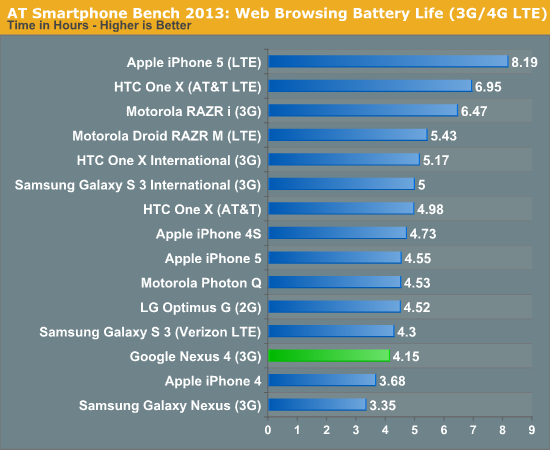
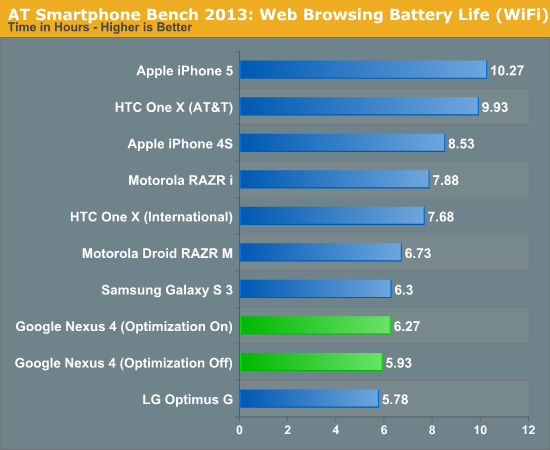
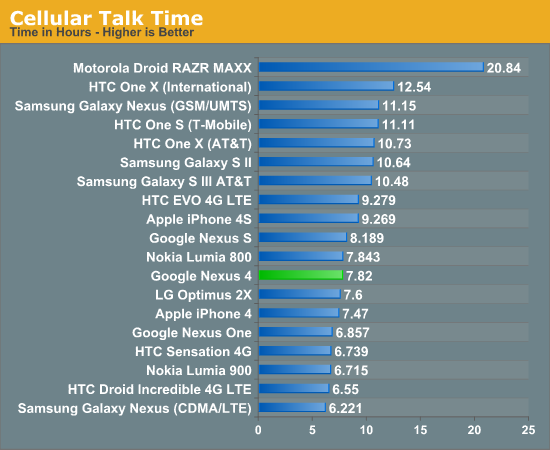
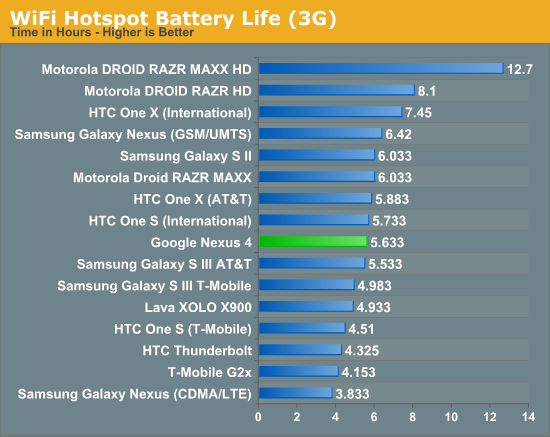
I've run and re-run the battery life tests on the Nexus 4 and they haven't changed since our preview a whole bunch. The result is battery life that isn't really chart topping, yet in my time with the Nexus 4 I haven't really been want for more battery life at any point. I'm able to get through a single day with the device set on auto brightness.



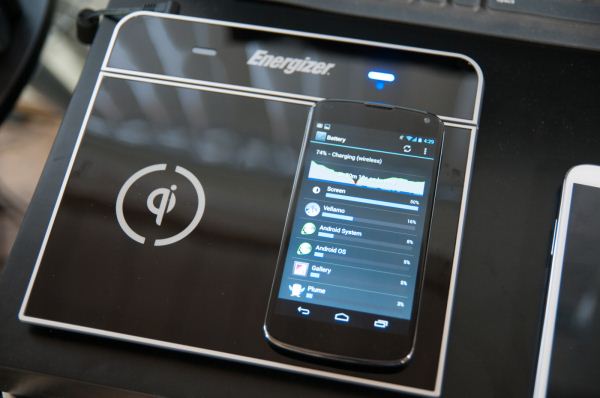

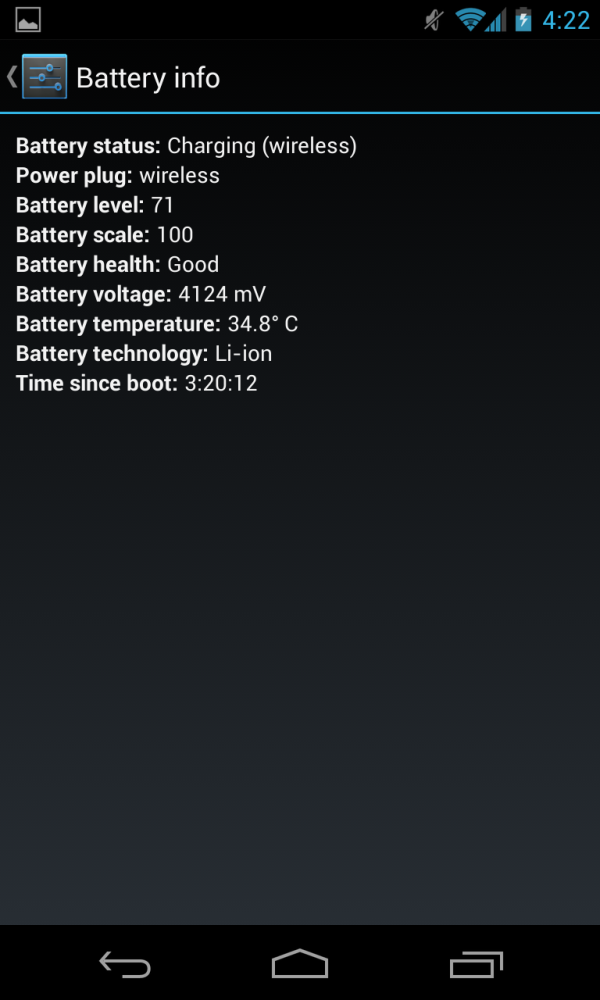








188 Comments
View All Comments
hulabaloo - Tuesday, November 13, 2012 - link
"We now have a form factor of device for every two inches of diagonal difference. "Should be three inches?
kyuu - Tuesday, November 13, 2012 - link
Thanks for the in-depth review, Mr. Klug. Greatly appreciated.Question: Is there a review for the Lumia 920 in the works? I'd really love to see a thorough review on it like this one from yourself or Anand.
aryonoco - Tuesday, November 13, 2012 - link
Thanks Brian, you've outdone yourself yet again. There is literally no reason to read any other Nexus 4 review.And also, a huge hats off to Anand for employing the very talented Brian and giving him a platform to show of his talents. You guys rock!
tuxRoller - Tuesday, November 13, 2012 - link
I suppose the end result explains how thry achieved the price of $300.About the SoC, is there anyway AT could do a more detailed review of the s4 pro? Perhaps something like what you did for Swift?
There is something seriously wrong with the s4 pro. Singke threaded performance shouod be really similar to the s4 but it is always as good bit slower. The memory performance has likewise regressed.
Has there been actual architectural changes made that causes this or is it something software releated (perhaps core affinity is nonexistent causing processes to keep moving between cores thus harming single thread performance).
Slaps - Tuesday, November 13, 2012 - link
""First, audioflinger is set to 48 kHz which results in software resampling causing artifacts for 41.1 kHz source material.""I think you mean 44.1 kHz not 41.1 kHz :)
Conficio - Tuesday, November 13, 2012 - link
Hi Brian,thanks for all the hard work that flowed into this review. Your drive to put out the best reviews is evident and you are succeeding when measured in the amount of data and information.
However, I'm considering this phone for my wife, and wanted to send it to her for a read. That is until I realized the enormous amount of comparisons to other phones, to other chips, etc. make it a really hard read. Somehow the text is a review and a history lesson mixed in one. I'd wished there would be a structure like the following:
* Introduction
* Form factor, feel, usability
* The phone's innards and benchmarks
* Comparison to phone X
* Comparison to phone Y
...
* The good, the bad, the ugly and conclusion
Funny that I'm as ambivalent about the phone. On the one side it looks great on price and basic features and independence of carriers and phone companies and their skin shenanigans (Why don't they compete on useful social or productivity software or at least make the skin removable). And I don't even need LTE, and can live w/o more memory. But then there is the thermal throttling going on and that just makes me uneasy. While it may not mean that much in today's real world applications, it is unnerving, that performance is something not reliable. It is there, but when you really use it it disappears. Reminds me of the unlimited ISP plans with speeds depending on your neighbor's usage and caps set so that they'll hurt in three years. I hope for really useful apps in three years to actually catch up to four cores.
What also bother's me is the camera. The low light performance is xoxo. But this horrible yellow tint is not something I'd appreciate. Can anybody recommend PC/ Mac OS X software to correct this? Can one set up something like a monitor calibration profile?
Conficio - Tuesday, November 13, 2012 - link
For a few years now we had the death grip test in every phone test. Has this problem disappeared altogether? How do we know? Due to tests or any other characteristic?staticx57 - Tuesday, November 13, 2012 - link
Not a problem with the review itself, but chrome is so far behind on Android that it absolutely kills the experience. If you compare AOSP browser vs chrome, not only does the AOSP browser faster in feel but kills chrome in benchmarks. It is pathetic that the Nexus 4 with krait scores 1800 ms sunspider but the Gnex on AOSP scores much better says something about the software Google chose to ship with.Impulses - Tuesday, November 13, 2012 - link
Google really needs to address this... Whether they need to start optimizing for the most popular SoC or simply update faster, it should not be that hard for them to improve on it.thesavvymage - Wednesday, November 14, 2012 - link
is there a way to just install the AOSP browser on the nexus? mine should be arriving friday if they ship on time and on my dad's gs3 i wasnt too impressed with chrome either